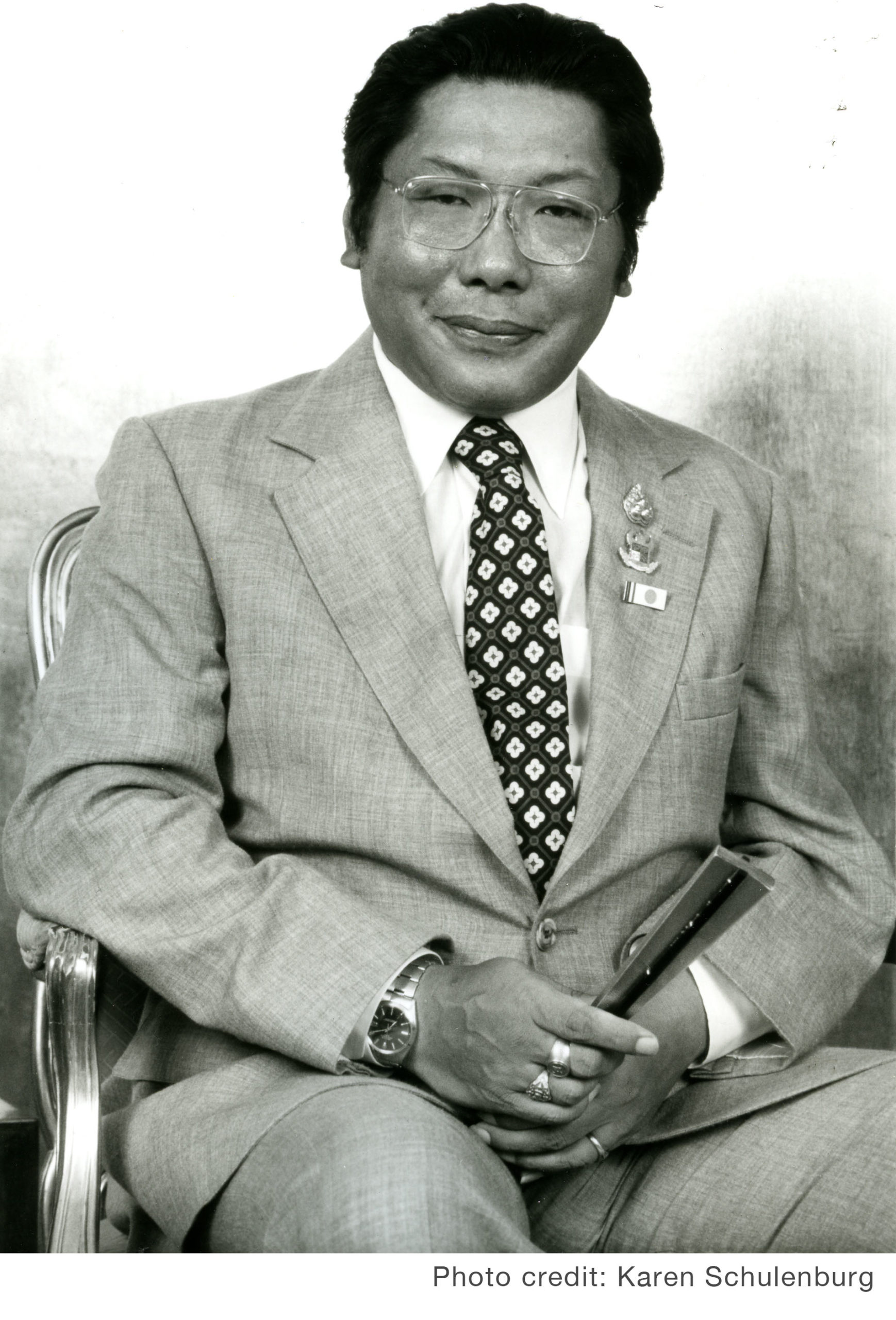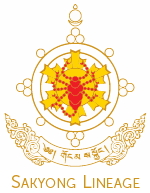What is a Sakyong?
The word sakyong means “earth protector.” It points to every individual’s potential to illuminate their life with wisdom, compassion, and virtue. Sakyong also refers to a lineage of leaders who over the centuries have joined enlightened vision with worldly activity to achieve peace, especially in times of turmoil. A Sakyong is regarded as a chögyal (Sanskrit dharmaraja) or “dharma king.” In Asian history there are many examples of dharmarajas, including the highly realized yogi-ruler Indrabhuti; King Suchandra (Tib. Dawa Sangpo) and the successive rulers of the legendary Shambhala kingdom; Ashoka, one of the most famous rulers in Indian history; and the Tibetan King Trisong Detsen, who helped establish Buddhism there. This rulership tradition continues through the Sakyong lineage of Shambhala, which upholds the view of basic goodness and creating good human society to benefit the world.
Sakyong Mipham Rinpoche, Jampal Trinley Dradül
 Sakyong Mipham Rinpoche is the second holder of the Sakyong lineage, also known as the Shambhala lineage. Born in India in 1962, he is the spiritual- and family-lineage successor of his father, Chögyam Trungpa Rinpoche, who was instrumental in bringing Buddhism to the West. In 1979, Chögyam Trungpa Rinpoche performed a ceremony officially investing his son with the title of Sawang, “earth lord,” confirming him as his Shambhala heir and the future Sakyong. In May 1995, in a public ceremony in Halifax, Nova Scotia, Canada, he was enthroned as Sakyong by His Holiness Penor Rinpoche.
Sakyong Mipham Rinpoche is the second holder of the Sakyong lineage, also known as the Shambhala lineage. Born in India in 1962, he is the spiritual- and family-lineage successor of his father, Chögyam Trungpa Rinpoche, who was instrumental in bringing Buddhism to the West. In 1979, Chögyam Trungpa Rinpoche performed a ceremony officially investing his son with the title of Sawang, “earth lord,” confirming him as his Shambhala heir and the future Sakyong. In May 1995, in a public ceremony in Halifax, Nova Scotia, Canada, he was enthroned as Sakyong by His Holiness Penor Rinpoche.
Sakyong Mipham Rinpoche is unique in that he bridges two worlds—Eastern and Western. He was raised in Great Britain and the United States, receiving traditional leadership and meditation training from his father at an early age. When his father passed away in 1987, the Sakyong spent several years studying in India, where he received teachings and transmissions from some of the greatest masters of the Nyingma and Kagyü schools of Tibetan Buddhism, including His Holiness Dilgo Khyentse Rinpoche and His Holiness Penor Rinpoche.
As a holder of both the Nyingma and Kagyü lineages, Sakyong Mipham Rinpoche is recognized as an incarnation of Jamgön Mipham Jamyang Gyatso (1846–1912), who was considered an emanation of Manjushri, the bodhisattva of wisdom. Known as Mipham the Great, he was one of the most revered meditation masters and scholars of Tibet. He was the author of a large collection of Buddhist practices and literature, as well as volumes on wide-ranging topics such as poetics, art, alchemy, and medicine. Near the end of his life, Mipham the Great prophesied that he would be “reborn in Shambhala.”
Through his father’s family, the Mukpo clan, Sakyong Mipham Rinpoche is a direct descendant of the eleventh-century Tibetan warrior and dharma king, Gesar of Ling. The warriorship tradition of Gesar emphasizes confidence and bravery as the basis for overcoming worldly and spiritual obstacles. The Gesar epic is reputed to be the longest single piece of literature in the world. Its stories and teachings are performed, celebrated, and preserved in Tibet and other Himalayan cultures, as well as parts of Central Asia and China. Following the footsteps of both his father Chögyam Trungpa and his predecessor Mipham the Great, who were greatly influenced by Gesar’s story, Sakyong Mipham Rinpoche continues to draw inspiration from it, teaching it and composing practices that invoke Gesar’s extraordinary spirit, power, and blessings.
“If you look at enlightenment in terms of the warrior principle,
it is manifesting as Gesar.”
— Sakyong Mipham Rinpoche —
In 2008, over a three-month period in Orissa, India, His Eminence Namkha Drimed Rinpoche conferred the Rinchen Terdzö on Sakyong Mipham Rinpoche. The Rinchen Terdzö is a collection of nearly 900 empowerments and teachings that represent the heart of the terma (“treasure”) tradition of the Nyingma lineage, which holds the earliest transmission of buddhadharma from India to Tibet. Because Namkha Drimed Rinpoche had received the Rinchen Terdzö from Chögyam Trungpa Rinpoche, this was an historic event in the continuity of the Sakyong lineage. The empowerments represented the Sakyong fully receiving his father’s transmission of the Nyingma lineage, which is intimately connected with the Shambhala teachings. In 2011 Namkha Drimed Rinpoche also bestowed the Nyingma Kama empowerments on the Sakyong, which represent the oral transmission the Nyingma received from India from the time of their arrival in Tibet, and in 2015 Namkha Rinpoche bestowed his own mind-terma lineage of Gesar on the Sakyong, the largest terma cycle of Gesar in the world.
For over three decades as the lineage holder of Shambhala, Sakyong Mipham Rinpoche has led many meditation retreats, ranging from public weekends to three-month seminaries for committed students from around the world. His teachings show how to create both spiritual and worldly success by joining the challenges of everyday life with gentleness and fearlessness. They emphasize the importance of hearing, contemplating, and meditating as the fundamental building blocks of understanding and practicing dharma at all levels. The Sakyong has guided thousands of students through the hinayana, mahayana, and vajrayana stages of the path, uniting the profound wisdom of the Shambhala terma with the traditional teachings of Buddhism. His presentation of warriorship and buddhadharma offers a potent and practical antidote to the loss of heart and humanity in the modern world. In his current activities as a lama and guru, he continues to tirelessly illuminate the way of awakenment, guiding students along the path of liberation in order to benefit all beings.
The Sakyong is the author of Turning the Mind into an Ally, Ruling Your World, Running with the Mind of Meditation, The Shambhala Principle, and The Lost Art of Good Conversation. He has published three books of poetry, as well as many texts, liturgies, and commentaries on meditation practices. The full collection of his published works (some restricted) can be found at Kalapa Publications. Additional online and recorded teachings are available at Kalapa Media.
Sakyong Mipham is married to Khandro Tseyang Palmo Mukpo, who is the youngest daughter of His Eminence Kyabje Namkha Drimed Rabjam Rinpoche, head of the Ripa lineage. The Sakyong and Sakyong Wangmo have three daughters: Drukmo Yeshe Sarasvati Ziji Mukpo, Yudra Lhamo Yangchen Ziji Mukpo, and Dzedrön Ökar Yangchen Ziji Mukpo.
The First Sakyong, the Dorje Dradül of Mukpo,
Chögyam Trungpa Rinpoche
 Chögyam Trungpa Rinpoche, the Dorje Dradül of Mukpo (1940–1987), is the first Sakyong (“Earth Protector”) and family lineage holder of the Sakyong lineage of Shambhala. Known as the “Druk Sakyong,” or “Dragon Earth-Protector,” Trungpa Rinpoche was empowered as Sakyong by His Holiness Dilgo Khyentse Rinpoche in a ceremony held in Boulder, Colorado in 1982. From an early age, Trungpa Rinpoche was known in Tibet as particularly gifted at receiving terma, or “concealed treasure,” teachings. In modern times he is known as a great tertön or treasure revealer through his discovery of the Shambhala terma. As a renowned Tibetan meditation master, scholar, artist and poet, Trungpa Rinpoche was instrumental in transmitting and transplanting of the teachings of Buddhism in the West.
Chögyam Trungpa Rinpoche, the Dorje Dradül of Mukpo (1940–1987), is the first Sakyong (“Earth Protector”) and family lineage holder of the Sakyong lineage of Shambhala. Known as the “Druk Sakyong,” or “Dragon Earth-Protector,” Trungpa Rinpoche was empowered as Sakyong by His Holiness Dilgo Khyentse Rinpoche in a ceremony held in Boulder, Colorado in 1982. From an early age, Trungpa Rinpoche was known in Tibet as particularly gifted at receiving terma, or “concealed treasure,” teachings. In modern times he is known as a great tertön or treasure revealer through his discovery of the Shambhala terma. As a renowned Tibetan meditation master, scholar, artist and poet, Trungpa Rinpoche was instrumental in transmitting and transplanting of the teachings of Buddhism in the West.
At the age of thirteen months, Trungpa Rinpoche was recognized as a tülku, or reincarnation of an enlightened teacher, in the Kagyü lineage. He underwent intensive training in meditation, philosophy, and fine arts in the Buddhist tradition of Tibet, receiving full ordination as a monk in 1958 at the age of eighteen. He was the supreme abbot of the Surmang monasteries, Governor of the Surmang District in Eastern Tibet, and a holder of both the Kagyü and Nyingma lineages of Tibetan Buddhism. Trungpa Rinpoche received the Rinchen Terdzö at the age of 12 and was renowned for bestowing it himself at the age of 14, and again later at 18, just before his journey to India.
In 1959, Trungpa Rinpoche led over 300 Tibetans across the Himalayas to northern India in a perilous escape from the Chinese Communists—an arduous nine-month journey recounted in his autobiography, Born in Tibet. Between 1963 and 1970, he studied comparative religion on scholarship at Oxford University. While living in England, he helped found the first Tibetan Buddhist monastery in the West, Samye Ling.
In 1970, at the invitation of his North American students, Trungpa Rinpoche moved to the United States. From 1973 through 1986, he taught the three yanas of Buddhism in depth to Western students during thirteen three-month-long seminaries held in various places in North America. These teachings are compiled in The Profound Treasury of the Ocean of Dharma. His compassion and extraordinary skill in transmitting ancient teachings of Buddhism in the context of Western culture allowed many students to gain direct experience of the highest wisdom of Tibetan vajrayana Buddhism.
In addition to the Tibetan lineages he held, Trungpa Rinpoche was deeply connected to and inspired by the ideals of the legendary kingdom of Shambhala and his family ancestor, King Gesar of Ling. Between 1976 and 1981, Trungpa Rinpoche experienced visions and revelations that he wrote down as a series of texts known as the Shambhala terma. These texts proclaim basic goodness as the nature of humanity and envision enlightened society as the basis for fully awakening to one’s innate wisdom and brilliance through everyday life while helping others to do the same. From the outset, these teachings profoundly altered Trungpa Rinpoche’s teaching and leadership of his community. This vision of enlightened society presents a sacred outlook that joins Buddhist wisdom with the aspiration to live fully in both the spiritual and secular worlds.
Drawing on both Eastern and Western cultural traditions as well as principles of warriorship of ancient Asia and Tibet, Trungpa Rinpoche established a path of meditation, a culture, and a social vision that he taught extensively in a series of seminars called Shambhala Training. Key teachings from these seminars are compiled in the books Shambhala: the Sacred Path of the Warrior, Great Eastern Sun, and Smile at Fear.
The legacy of Chögyam Trungpa Rinpoche also includes Naropa University in Boulder, Colorado. Founded in 1974, it is the first Buddhist-inspired university in North America. He established a global network of meditation and retreat centers known as Shambhala. Throughout his life, Trungpa Rinpoche gave talks on art, poetry, psychology, death and dying, and many more topics, both within the scope of Buddhism and in the context of the Shambhala teachings. To date, over forty volumes of his teachings have been published, in addition to recordings and talk transcripts.
